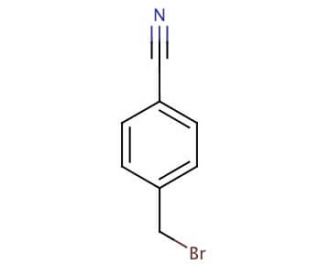

4-Cyanobenzyl Bromide 的分子结构, CAS编号: 17201-43-3
4-Cyanobenzyl Bromide (CAS 17201-43-3)
备用名:
4-Bromomethylbenzonitrile; Bromo(α-)-π-tolunitrile
CAS号码:
17201-43-3
分子量:
196.04
分子式:
C8H6BrN
仅供科研使用。不可用于诊断或治疗。
* 参考分析证明 大量特定数据 (包括水 含量).
快捷链接
订购信息
描述
技术信息
安全信息
安全技术说明书和分析证明书
4-氰基溴苄是一种用作芽后除草剂的苄基卤化物。4-氰基溴苄(4-CBB)因其合成各种化合物的显著多样性和广泛应用而在科学研究中受到广泛欢迎。在有机合成中作为试剂和催化剂,它在药物和其他生物活性化合物的创造中起着至关重要的作用。此外,它在这些合成过程中起着有价值的中间体作用。它的用途不仅限于此,因为它可以作为探索有机反应动力学和机理的模型系统。在科学研究中,4-氰基溴苄具有广泛的用途。它作为有机合成的试剂,有机反应的催化剂,以及药物和生物活性化合物生产的重要中间体。此外,研究人员将其用作研究有机反应复杂动力学和机理的有价值的模型。它的应用更加多样化,包括肽、拟肽和核苷的合成。4-氰基苄基溴的作用机理取决于它与各种官能团相互作用的能力。它与醛、酮和羧酸的反应产生酯,而它与胺形成酰胺。此外,4-氰基溴苄在与醇反应时可以产生醚,在与硫醇反应时可以形成硫醚。这些多用途的反应使其成为科学家探索有机化学复杂性的宝贵工具。
4-Cyanobenzyl Bromide (CAS 17201-43-3) 参考文献
- 氨基硼氢化物12.2-halobenzonitriles 与 N,N-二烷基氨基硼氢化锂的新型串联 S(N)Ar 氨基化还原反应。 | Thomas, S., et al. 2001. J Org Chem. 66: 1999-2004. PMID: 11300892
- 从电化学裂解反应活性对溶剂的依赖性得出的离子/自由基加合物在液相中的稳定性。 | Pause, L., et al. 2001. J Am Chem Soc. 123: 11908-16. PMID: 11724597
- 构象受限的戊脒同系物的杀锥虫活性。 | Donkor, IO., et al. 2003. J Med Chem. 46: 1041-8. PMID: 12620080
- 芳基四氢吡啶法尼基转移酶抑制剂:可生物利用的类似物,具有更好的细胞效力。 | Gwaltney, SL., et al. 2003. Bioorg Med Chem Lett. 13: 1363-6. PMID: 12657283
- 新型 2-吡啶基-[1,2,4]三唑作为转化生长因子 beta1 1 型受体抑制剂的设计, 合成和生物学评价。 | Kim, DK., et al. 2004. Bioorg Med Chem. 12: 2013-20. PMID: 15080905
- 基于活性的蛋白酪氨酸磷酸酶探针。 | Kumar, S., et al. 2004. Proc Natl Acad Sci U S A. 101: 7943-8. PMID: 15148367
- 溶剂对不稳定π离子自由基的存在及其异质裂解活化障碍的控制。 | Costentin, C., et al. 2004. J Am Chem Soc. 126: 16834-40. PMID: 15612722
- 芳香化酶抑制剂[(11)C-氰基]来曲唑(Femara)的合成与 PET 研究。 | Kil, KE., et al. 2009. Nucl Med Biol. 36: 215-23. PMID: 19217534
- 新型苄基取代 N-杂环碳烯-醋酸银配合物:合成, 细胞毒性和抗菌研究。 | Patil, S., et al. 2011. Metallomics. 3: 74-88. PMID: 21135954
- 腈基作为红外探针,用于表征溶解在反向胶束中的牛血清白蛋白的构象。 | Xue, L., et al. 2012. Spectrochim Acta A Mol Biomol Spectrosc. 97: 858-63. PMID: 22902928
- 在光氧化脱羧芳基硫化过程中作为可见光促光敏剂的 N-(乙酰氧基)邻苯二甲酰亚胺基团。 | Jin, Y., et al. 2016. Chem Commun (Camb). 52: 12909-12912. PMID: 27739553
- 边缘分化支柱[5]炔分子摆动的立体化学反转。 | Du, K., et al. 2020. J Org Chem. 85: 11368-11374. PMID: 32820630
- 异噁唑系列糖蛋白 IIb/IIIa 拮抗剂的合成和抗血小板作用。 | Xue, CB., et al. 1998. Bioorg Med Chem Lett. 8: 3499-504. PMID: 9934460
订购信息
| 产品名称 | 产品编号 | 规格 | 价格 | 数量 | 收藏夹 | |
4-Cyanobenzyl Bromide, 5 g | sc-216817 | 5 g | $23.00 |
